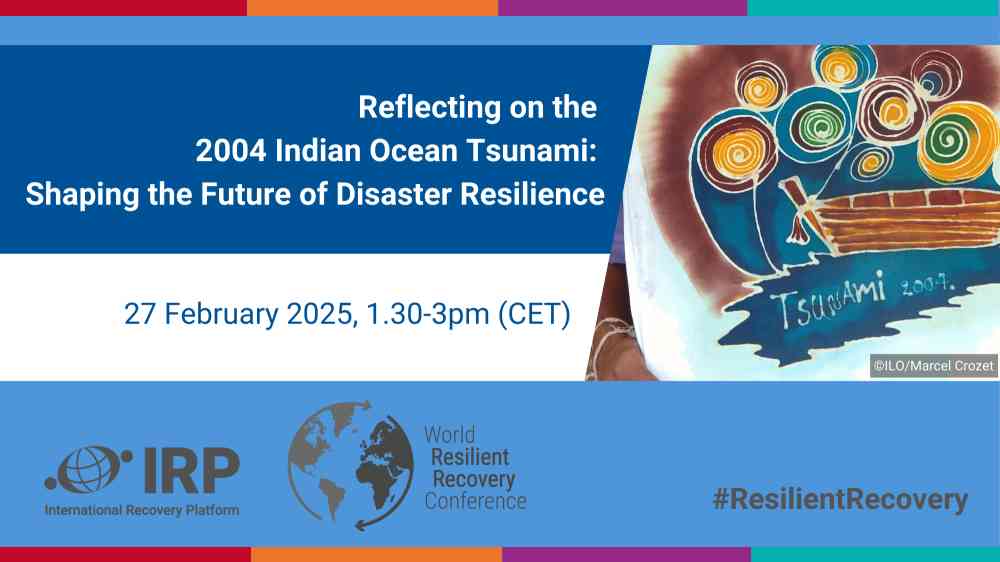WRRC Webinar: Reflecting on the 2004 Indian Ocean Tsunami: Shaping the Future of Disaster Resilience

- English
This webinar serves as a cornerstone event for the 2025 World Resilient Recovery Conference (WRRC), playing a critical role in advancing the global agenda for disaster risk reduction and recovery readiness. By reflecting on the legacy of the 2004 Indian Ocean Tsunami, it aims to inspire collective action and drive progress toward a more resilient future. As a foundational event leading up to the WRRC, which will take place just before the opening of the 8th Session of the Global Platform for Disaster Risk Reduction on 3 June 2025, this discussion will generate key insights and recommendations. These outcomes will directly inform the Global Call to Action for Investing in Readiness for Resilient Recovery, to be adopted at the WRRC and contribute to shaping global recovery strategies.
This webinar is co-organized by the United Nations Office for Disaster Risk Reduction (UNDRR), United Nations Development Programme (UNDP), United Nations Educational, Scientific and Cultural Organization (UNESCO), World Health Organization (WHO) and the Global Network of Civil Society Organisations for Disaster Reduction (GNDR).
Background
The 2004 Indian Ocean Tsunami was one of the most devastating disasters in modern history, claiming over 230,000 lives and causing widespread destruction across 14 countries in Asia and Africa. The disaster revealed significant gaps in global disaster preparedness and response, but also catalyzed transformative changes in disaster risk management, recovery strategies and early warning systems.
Over the past two decades, global efforts have led to critical advancements in DRR, including the establishment of the Indian Ocean Tsunami Warning and Mitigation System (IOTWMS), the adoption of the Hyogo Framework for Action (2005-2015) and its successor, the Sendai Framework for Disaster Risk Reduction (2015-2030). However, challenges remain, particularly in ensuring inclusive, sustained and adequately funded disaster recovery efforts.
Session objectives
This webinar will reflect on the 2004 Indian Ocean Tsunami as a turning point for global disaster risk reduction and recovery readiness. By examining the lessons learned, progress made and gaps that remain, this discussion will generate key insights to advance resilient recovery efforts. The session will explore governance, financing, early warning systems and the role of inclusive recovery in shaping disaster resilience.
The outcomes of this session will directly contribute to the Global Call to Action for Investing in Readiness for Resilient Recovery and inform the broader agenda of the 2025 WRRC. By reflecting on the long-term impacts of the 2004 Indian Ocean Tsunami, this discussion will provide actionable recommendations for accelerating progress on the principles of “Building Back Better” and strengthening disaster resilience. The insights gathered will contribute to shaping inclusive recovery frameworks, emphasizing the need to address vulnerabilities, integrate community voices, and ensure equitable recovery processes in future disaster preparedness and recovery strategies.
The session further aims to:
- Understand how the Indian Ocean Tsunami became a turning point for greater investments in disaster risk reduction and related areas via the Hyogo Framework and the Sendai Framework on Disaster Risk Reduction, reflecting upon how large-scale resource mobilization was realized.
- Understand how the establishment of an Indian Ocean Tsunami Early Warning Systems was made possible across the region and reflect on the progress made since then in terms of governance to reach the last mile of early warning systems.
- Reflect on lessons learnt in Building Back Better following the Tsunami and where progress is still needed to accelerate.